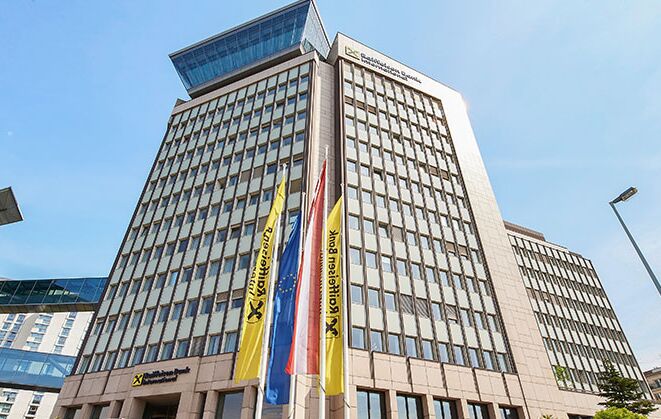SER Blog Customer Stories & Use Cases
Document management at Raiffeisen Bank International
Wolfgang Rachbauer

Our objective at RBI has been to implement a single source of truth for the archiving of customer-related documents and fulfillment of regulatory requirements. We were looking for a document management system to help us achieve this. All information from various sources had to be channeled through the centralized DMS. At the same time, standardized digital information management is providing the basis for meeting compliance requirements, such as ensuring retention periods and data protection according to EU GDPR.
Today’s DMS: More than an archive
We have to digitize workflows and create fast, end-to-end processes. With Doxis, RBI now has an in-house system that combines document and process management. An integrated document management system (IDMS) was put into operation, which has enabled RBI to successfully implement, for the first time, an innovative, centralized and future-proof document management solution at its corporate headquarters.
The roll-out of the IDMS was coordinated by a range of specialists in the areas of project management, IT, credit and processing, together with their counterparts at SER Group. The project focused on agile software development, a method of efficient project management that is suited ideally to this project. In addition to defining the practical scope and describing the solution’s functionalities, the team also began to configure the application. After a few months, the first prototypes were released for testing by a limited number of users.
Migration activities began a few weeks prior to the planned deployment date, i.e. a large number of documents (loan agreements, collateral agreements, sample signature sheets, copies of ID cards, etc.) was transferred from local storage locations and network drives to the new document management system. The aim was to make all these documents available to users in the new system on the go-live date so that the areas affected by this project, in the first phase, would be able to access their documents in the new application from the outset.
A detailed training plan ensured that all users were familiar with the new system in the weeks prior to its launch. Video tutorials, FAQ documents and online training provided additional training support.
Here is a summary of the key benefits of the new system:
1. Audit trail
The audit trail provides the security that not only are all versions of documents drafted during customer negotiations stored electronically, but also subsequent audits can clearly identify who worked on the contract, what modifications or additions were made, and when these versions were created.
2. Digitalization and centralization
Many documents from various (physical and electronic) archives were filed electronically in the document management system. This made it possible to save space and shut down decentralized drives.
3. Data quality
In the course of the project, extensive measures were taken to increase data quality: documents were assigned metadata, which allowed for a range of additional information to be saved with the relevant documents. Many documents were reclassified and divided into document types, which in turn makes searching easier. Many were also re-scanned and saved again in multiple formats.
4. Single point of truth
The concept of having a single version in the entire bank that serves as the final valid document for everyone may seem trivial at first. However, if you consider how many drafts of a document are sent back and forth between the departments involved (legal, compliance, contract documentation, contract processing, etc.) and how many versions these parties save on their local drives or in their personal mail system, then you can imagine the importance of having a single point of truth. Every document now has one specific storage location, where this document can be found in its latest version, and an owner (a person or a department). Employees are no longer allowed to store documents on local drives, as everything has to be filed in the new application.
5. Access rights
The new system of document management can also manage highly complex access authorizations. For example, requirements for “Chinese walls” can be implemented in different departments in the bank; different read and write authorizations can be granted. The inescapable need-to-know principle of the new EU General Data Protection Regulation is also an important element of the document management solution.
6. Flexible search functions and character recognition
By processing the documents in an OCR-compatible format, users can conduct a full-text search for specific words or parts of sentences using a full-text search.
7. Document management competence center
A multi-person competence center was set up within the bank to answer questions from users, to grant access rights and, primarily, to distribute the application to all the relevant departments at RBI. This also ensures that the application supports new procedures and processes in the best possible manner and that further efficiency potential can be exploited.
Next: Digital end-to-end processes & artificial intelligence
After the project is before the project: The new document management system can support an astoundingly high number of processes. New use cases are continuously being explored by our teams at RBI. These could cover loan applications, loan approvals or contract creation processes – all from the point of view of digitizing end-to-end processes and improving their efficiency.
The next important step is to evaluate the use of artificial intelligence in the framework of loan agreement management. This means not only producing loan agreements efficiently and securely, but also locating the content of contracts quickly – separately from OCR searches. The goal is to benefit from natural language processing in document layout and management, i.e. nothing less than "reading a loan agreement like a human being."
Wolfgang Rachbauer
Wolfgang Rachbauer heads the Credit Office department of Raiffeisen Bank International in Vienna, Austria. His department specializes in loan structuring and contract management. Rachbauer was a member of the project team that implemented the document management system at RBI. He is currently developing solutions to apply artificial intelligence in loan agreement management.

The latest digitization trends, laws and guidelines, and helpful tips straight to your inbox: Subscribe to our newsletter.
How can we help you?
+49 (0) 30 498582-0Your message has reached us!
We appreciate your interest and will get back to you shortly.




